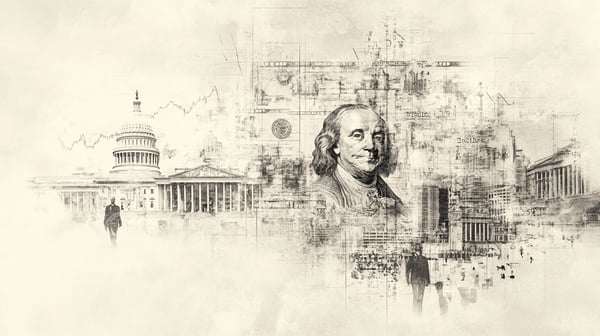How Stablecoins are set to stabilize US debt market

Blockchain and crypto аре undoubtedly changing the world, and the first candidate for substitution is, of course, the financial system. The current financial system is in dire need of a major restructuring since it blew up in 2008 (hint: it was not the subprime issue, it was a global disaster). Since then, it has been a rollercoaster ride of crises and permanent market shake-ups. It has been almost two decades since the Global Finance Crisis (GFC) and it seems nothing has changed - we still live in a world constrained by the inefficient, fragile and over-regulated industry. Well, in the world of ever-growing debt levels and budget deficits, the idea of restarting the new system from scratch seems like a far-fetched and dangerous enterprise. So we are basically down to a path, in which we try to use blockchain as the extension of the current system while trying to achieve change through efficiencies that are being offered by the blockchain technology.
Stablecoins are the spearhead of such extension efforts. Stablecoins, cryptocurrencies pegged to traditional assets like fiat currencies, are playing an increasingly prominent role in digital finance. Not only do they offer a transactional medium but also extend their presence far beyond the use case of payments. It is the integration of stablecoins and tokenization into the U.S. Treasury market (the process of digitizing real-world assets such as U.S. Treasuries on a blockchain platform) that heralds a transformative shift in financial infrastructure, leveraging blockchain technology to enhance efficiency, accessibility, and innovation. With stablecoin market capitalization reaching $166 billion in 2024, stablecoins have evolved into essential intermediaries for transactions in the cryptocurrency ecosystem. These assets are predominantly backed by short-dated U.S. Treasuries, with an estimated $120 billion invested directly in these securities. And even though, given the overall debt level of the US of $36 trillion, this figure might seem minuscule currently, the major effect is that such practice introduces new structural demand for Treasuries (in the times where Treasury is obviously experiencing problem on the demand side from the private sector) while laying the groundwork for broader adoption of tokenized financial systems. This is especially relevant given the problems we have been experiencing in the US Treasury market in the second half of 2024 on the back of ever-growing issuance and high volatility in the bond market.
Can the tokenization of the U.S. Treasuries save the world? Very unlikely, but it might buy us some time and will show us the direction in which the financial system will evolve in the near future. As such, tokenization represents a major evolution in financial market infrastructure. It promises to address inefficiencies inherent in traditional systems of clearing and settlement. Currently, transactions often involve multiple intermediaries and lengthy processes. Tokenized Treasuries, however, enable instantaneous settlement through "atomic settlement," where all elements of a transaction occur simultaneously, eliminating settlement risk. This capability is particularly appealing in high-frequency market operations such as repurchase agreements (repos), where timeliness and precision are critical. Additionally, smart contracts embedded in tokenized assets automate complex processes, such as collateral transfers upon pre-defined conditions, streamlining operations and reducing human error.
The benefits of tokenization also extend to market accessibility. By dividing assets into smaller digital fractions, tokenization democratizes access to Treasuries, allowing retail investors and institutions in emerging markets to participate more easily. This has the potential to attract new pools of savings, further increasing demand for Treasuries. Tokenized markets also enhance transparency, as immutable blockchain ledgers provide real-time visibility into asset ownership and transaction histories. This can reduce opacity in trading activities, benefiting regulators, issuers, and investors alike.
But there are also risks. From a technological standpoint, the transition to tokenized systems is costly and complex. While public blockchains, like Bitcoin and Ethereum, have popularized the concept of decentralized ledgers, they lack the scalability, security, and governance structures required for institutional-grade applications. Permissioned blockchains, managed by trusted public or private entities, are considered more suitable for the tokenization of U.S. Treasuries. These platforms ensure controlled access, robust security, and compliance with regulatory standards, mitigating risks such as hacking, operational failures, and fraud.
In the Treasury market, tokenization could exacerbate financial instability if not implemented prudently. Stablecoins, which rely heavily on short-dated Treasuries for collateral, are susceptible to market shocks. Past events, such as the collapse of Terra in 2022 and subsequent depegging of stablecoins like Tether and USD Coin, underscore the vulnerability of these systems. A major stablecoin collapse could trigger a "fire sale" of Treasury collateral, amplifying market volatility and disrupting liquidity. Moreover, tokenized markets, with their potential for 24/7 trading, could experience heightened volatility and susceptibility to market manipulation.
Tokenization also introduces interconnectedness risks. As tokenized assets link on-chain and traditional financial systems, disruptions in one segment could spill over into the broader market. This interconnectedness could amplify deleveraging effects during financial stress, similar to issues observed in traditional derivatives and stock markets. Furthermore, the use of smart contracts and programmable logic, while a strength of tokenization, could lead to unintended consequences if poorly coded, triggering financial transactions that destabilize markets.
From a regulatory perspective, tokenization adds complexity. Jurisdictional inconsistencies and unclear legal standards for digital assets create challenges for cross-border transactions and compliance.
The development of comprehensive regulatory frameworks is essential to address these issues. Initiatives like the EU's Markets in Crypto-Assets Regulation (MiCA) and the U.S. Financial Innovation and Technology for the 21st Century Act are steps in the right direction, but more cohesive global efforts are needed. Central bank digital currencies (CBDCs) could play a critical role in mitigating these risks. By providing a unified ledger system anchored in a government-backed digital currency, CBDCs could reduce reliance on private stablecoins and offer a secure foundation for tokenized transactions. Such a system would integrate seamlessly with existing regulatory structures and bolster trust among market participants. And while this seems to be the most likely path forward, the initial libertarian idea of the role of cryptocurrencies changing the world descends more and more into non-relevance. We just have to accept it.
Join Montes Auri on our path to become the leading licenced pan-european Crypto Bank.




